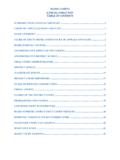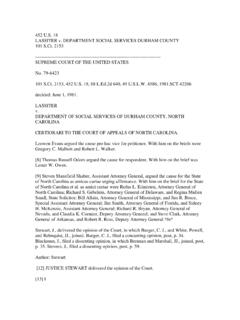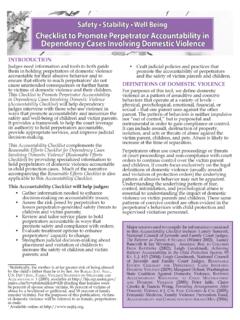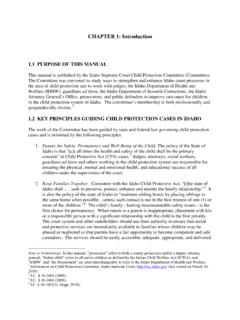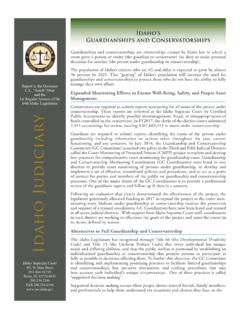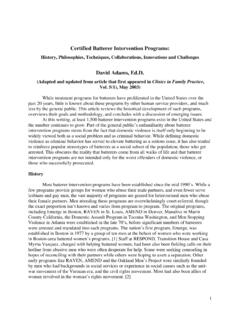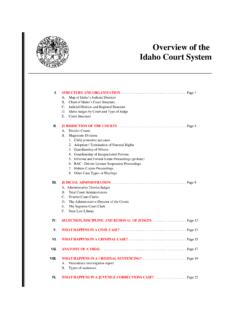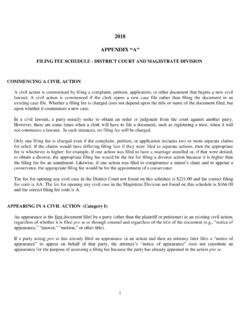Transcription of Domestic Violence Evaluation Screening/Assessment Tools
1 KEY:R = Risk AssessmentS = Substance AbuseM = Mental HealthC = Combination-Substance Abuse/Mental Health OR All three O = OtherV = Victim InformationTest TypeTest NameDescriptionAdministration QualificationsCostFor More Information:RDanger assessment (DA)The DA helps to determine the level of danger an abused woman has of being killed by her intimate partner. Using the DA requires the weighted scoring and interpretation that is provided after completing the training. The Danger assessment is available in a variety of languages. It is a paper and pencil checklist style instrument, based on the victim report. May be helpful to use during victim interview training available (may require a fee)Free. A copyright is held by the author but available with credit to author. Violence Inventory(DVI)The DVI is designed specifically for Domestic Violence offender assessment (male and female).
2 The DVI has 155 items and takes 30 minutes to complete. The DVI has six measures (scales): 1. Truthfulness Scale, 2. Violence (Lethality) Scale, 3. Control Scale, 4. Alcohol Scale, 5. Drugs Scale, and 6. Stress Coping Abilities Scale. No training needed to administer, scoring onlineCost for each test, available Violence screening Instrument (DVSI or DVSI-R)The DVSI consists of questions primarily related to criminal history of Domestic Violence and other violent offenses, including arrests, convictions and violation of restraining orders. Employment status, recent separation, and presence of children during the incident are the other risk factors probed. This instrument was designed as strictly statistical instrument which does not require inclusion of clinical training needed to administerTool is under copyright. Approval is necessary before Joseph DiTunno at Risk assessment of Dangerousness tool (IRAD) The IRAD identifies indicators of future risk of harm, as well as indicators of lethality.
3 The seven areas are: history of Domestic Violence , threat to kill victims and/or children or others (parents, friends), threats of suicide, recent separation, obsessive, coercive, or controlling behavior, prior police contact, alcohol or drug use and abuse by training needed to administer, scoring onlineFree printable version by the Domestic Assault and Battery Advisory Board (July 1, 2018) Evaluations per Idaho Criminal Rule (a)(2)(P); (a)(3)(F); and (a)(3)(J) must include a listing of the screening or assessment Tools utilized in the Evaluation together with the results. The use of at least one screening or assessment tool approved by the Domestic Assault and Battery Evaluator Advisory Board is mandatory for each category (Risk, Substance Abuse, and Mental Health).
4 Domestic Violence Evaluation Screening/Assessment ToolsThe use of at least one RISK, SUBSTANCE ABUSE, and MENTAL HEALTH screening or assessment tool from the below list is mandatory. Combination Tools may be used for both or all three areas (depending on type).Test TypeTest NameDescriptionAdministration QualificationsCostFor More Information:ROntario Domestic Assault and Risk assessment (ODARA)It is an actuarial tool comprised of 13 factors for the Assessor to rate. The factors considered are threats to harm or kill; prevent victim from leaving; offender s substance abuse; prior police involvement for Violence ; prior police involvement for other crimes; general Violence with others; prior jail or prison time more than 30 days; violation of probation, parole, bail, or protection order; number of children in common, number of children for victim only; ever assaulted during pregnancy; concern from victim for future Violence ; and barriers to victim support.
5 Online training available (may be a fee)Free. Contact author for Assault Risk Appraisal Guide (SARA)The SARA is a quality-control checklist that determines the extent to which a professional has assessed risk factors of crucial predictive importance according to clinical and empirical literature. The SARA assessment screens for risk factors in individuals suspected of or being treated for spousal or family-related assault. Scores based on information from multiple available (may require fee)Cost for checklist, available Appraisal of Individual Needs (GAIN-I)The GAIN-I is a comprehensive bio-psychosocial assessment designed to support clinical diagnosis, placement, treatment planning, performance monitoring, program planning and economic analysis. Measures primarily substance abuse with AXIS requiredManual and use of the tool can be obtained through Chestnut.
6 Fees Appraisal of Individual Needs Short Screener (GAIN-SS)The GAIN-SS is used for substance abuse primarily. This 5-minute tool is designed to serves as a screener in general populations to quickly and accurately identify clients whom the full GAIN I would identify as having one or more behavioral health disorders ( , internalizing or externalizing psychiatric disorders, substance use disorders, or crime or Violence problems), which suggests the need for referral to some part of the behavioral health treatment formal training needed to and use of the tool can be obtained through Chestnut. Fees Abuse Subtle screening Inventory, multiple editions (SASSI)The SASSI contains both subtle and face valid items validated to screen for high or low probability of having a substance use disorder. Described as effective in identifying those in denial or deliberately trying to conceal their substance use, it is longer than brief face valid screens.
7 It also contains a validity scale to identify random responding, and a defensiveness scale, which provides a measure of credibility to the individual s availableManual and tool are available online to order-requires a fee Substance Use Survey (ASUS-R)The ASUS-R is a self-report survey designed to Screen and assess an individual s alcohol and other drug use. The ASUS-R provides a mental health screen, a scale that measures social non-conformity and a scale that measures legal module available online (requires a fee)Test and manual are free Severity Index (ASI)The ASI is a semi-structured interview designed to address seven potentialproblem areas in substance-abusing patients: medical status, employmentand support, drug use, alcohol use, legal status, family/social status, andpsychiatric status. In 1 hour, a skilled interviewer can gather informationon recent (past 30 days) and lifetime problems in all of the problem ASI provides an overview of problems related to substance, as well as the substances themselves.
8 NoneNone. Available TypeTest NameDescriptionAdministration QualificationsCostFor More Information:SDrug Abuse screening Test (DAST)All the DAST versions screen for problems with the use of drugs only. The DAST-10 is the shortened and more commonly used version of a 20-item (DAST-20) or the original 28-item version. The DAST is sometimes combined with the AUDIT or other alcohol screens to cover both alcohol- and drug-related problems. Items apply to over-the-counter, prescription, and illicit Available Alcohol Use Disorders Identification Test (AUDIT)The AUDIT was developed to identify persons whose alcohol consumption has become harmful or hazardous to their health. The AUDIT is not designed to identify substance use disorders according to diagnostic criteria. The AUDIT is designed for written administration, but is short enough to be read to a respondent for oral Available or CAGE- AIDThe CAGE, a very brief screen, is probably the most widely used and promoted for the detection of alcohol problems.
9 The CAGE-AID is a version of the CAGE alcohol screening questionnaire, adapted to include drug use. It assesses likelihood and severity of alcohol and drug Available Alcohol screening Test (MAST)The MAST tool was developed in 1971 and is one of the oldest alcoholism screening tests in identifying dependent drinkers. Its use is constructed for the general population. All of the mast screening Tools are scored on a point scale Available Inventory for DSM-5 (PID-5)This tool is a self-rated personality trait assessment scale. It assesses 25 personality trait facets including Anhedonia, Anxiousness, Attention Seeking, Callousness, Deceitfulness, Depressivity, Distractibility, Eccentricity, Emotional Lability, Grandiosity, Hostility, Impulsivity, Intimacy Avoidance, Irresponsibility, Manipulativeness, Perceptual Dysregulation, Perseveration, Restricted Affectivity, Rigid Perfectionism, Risk Taking, Separation Insecurity, Submissiveness, Suspiciousness, Unusual Beliefs and Experiences, and by a highly trained Form (PID-5-BF)The Personality Inventory for DSM-5 Brief Form is a self-rated personality trait assessment scale.
10 It assesses 5 personality trait domains including negative affect, detachment, antagonism, disinhibition, and by a highly trained SUB & MHMillon Clinical Multiaxial Inventory(MCMI-IV) The primary intent of the MCMI inventory is to provide information to clinicians, who must make assessments and treatment decisions about persons with emotional and interpersonal difficulties. The MCMI-IV consists of a total of 25 scales: 15 Clinical Personality Patterns scales; 3 Severe Personality Pathology scales; 3 Severe Clinical Syndrome scales; 3 Modifying Indices; an Inconsistency scale; and a Validity scale. The personality scales parallel the personality disorders of the degree and formal training in ethical administration of clinical for answer sheets (test booklets and manual extra) SUB & MHMinnesota Multiphasic Personality Inventory (MMPI-2)The MMPI-2 is one of the most frequently used personality tests in mental health.
